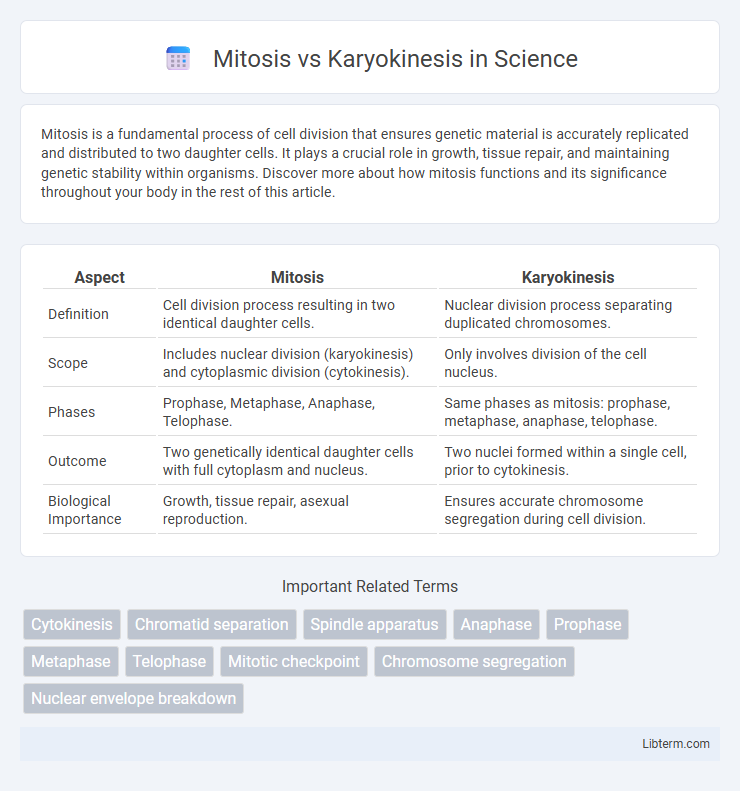Mitosis is a fundamental process of cell division that ensures genetic material is accurately replicated and distributed to two daughter cells. It plays a crucial role in growth, tissue repair, and maintaining genetic stability within organisms. Discover more about how mitosis functions and its significance throughout your body in the rest of this article.
Table of Comparison
| Aspect | Mitosis | Karyokinesis |
|---|---|---|
| Definition | Cell division process resulting in two identical daughter cells. | Nuclear division process separating duplicated chromosomes. |
| Scope | Includes nuclear division (karyokinesis) and cytoplasmic division (cytokinesis). | Only involves division of the cell nucleus. |
| Phases | Prophase, Metaphase, Anaphase, Telophase. | Same phases as mitosis: prophase, metaphase, anaphase, telophase. |
| Outcome | Two genetically identical daughter cells with full cytoplasm and nucleus. | Two nuclei formed within a single cell, prior to cytokinesis. |
| Biological Importance | Growth, tissue repair, asexual reproduction. | Ensures accurate chromosome segregation during cell division. |
Introduction to Cell Division
Mitosis and karyokinesis are fundamental processes in cell division, with mitosis referring specifically to the division of the nucleus resulting in two genetically identical daughter nuclei. Karyokinesis encompasses the entire nuclear division process, including the phases of prophase, metaphase, anaphase, and telophase, ensuring accurate chromosome separation. Together, these mechanisms maintain genetic stability during cell proliferation, critical for growth, development, and tissue repair.
Defining Mitosis and Karyokinesis
Mitosis is a type of cell division resulting in two genetically identical daughter cells, crucial for growth and tissue repair. Karyokinesis refers specifically to the division of the cell nucleus during mitosis, ensuring equal distribution of chromosomes. While mitosis encompasses the entire process of nuclear and cytoplasmic division, karyokinesis focuses solely on the nuclear partitioning phase.
Key Stages of Mitosis
Mitosis consists of key stages including prophase, metaphase, anaphase, and telophase, where chromosomes condense, align at the cell equator, separate, and reach opposite poles respectively. Karyokinesis refers specifically to the division of the nucleus, which occurs during these stages of mitosis, ensuring equal chromosome distribution to daughter nuclei. Understanding mitosis stages is essential for distinguishing how karyokinesis orchestrates nuclear division within the overall cell cycle.
Understanding Karyokinesis: Process and Purpose
Karyokinesis is the process of nuclear division during cell division, where the duplicated chromosomes are separated into two daughter nuclei. It is a crucial phase of mitosis, ensuring the accurate distribution of genetic material to maintain chromosomal integrity. Understanding karyokinesis involves analyzing its stages--prophase, metaphase, anaphase, and telophase--that coordinate chromosome alignment, separation, and nuclear membrane reformation.
Differences Between Mitosis and Karyokinesis
Mitosis is the entire process of nuclear division that results in two genetically identical daughter cells, encompassing stages such as prophase, metaphase, anaphase, and telophase. Karyokinesis specifically refers to the division of the nucleus itself, which is a critical component but does not include cytokinesis, the division of the cytoplasm. Mitosis includes both karyokinesis and cytokinesis, whereas karyokinesis alone only addresses nuclear splitting without leading immediately to cell division completion.
Similarities in Mechanisms and Functions
Mitosis and karyokinesis both involve the precise replication and segregation of chromosomes to ensure genetic consistency in daughter cells. Each process includes stages such as prophase, metaphase, anaphase, and telophase, which coordinate chromosomal alignment and separation. Their primary function supports cell division, maintaining genomic stability during growth, development, and tissue repair.
Biological Significance in Growth and Development
Mitosis ensures accurate chromosome segregation, maintaining genetic stability crucial for cellular proliferation and tissue growth. Karyokinesis, the division of the nucleus, enables precise distribution of genetic material, facilitating organismal development and repair. Both processes are fundamental to maintaining cellular function and promoting coordinated growth in multicellular organisms.
Errors in Mitosis and Karyokinesis: Consequences
Errors in mitosis and karyokinesis can lead to significant cellular abnormalities, including aneuploidy and genomic instability, resulting in diseases such as cancer. Faulty mitosis may cause unequal chromosome segregation, while errors in karyokinesis disrupt the proper division of the nucleus, impairing cell function and viability. These mitotic and karyokinetic defects compromise tissue homeostasis and contribute to developmental disorders and tumor progression.
Karyokinesis vs Cytokinesis: A Comparative Overview
Karyokinesis refers to the process of nuclear division, where the duplicated chromosomes are equally separated into two daughter nuclei during cell division. Cytokinesis is the subsequent physical division of the cytoplasm, resulting in two distinct daughter cells, completing the cell division cycle. While karyokinesis ensures genetic material is accurately distributed, cytokinesis finalizes the separation by partitioning cellular contents, making both processes essential but distinct stages of mitosis.
Summary and Future Research Directions
Mitosis and karyokinesis are fundamental processes in cell division, with mitosis encompassing the entire division of a cell's nucleus, resulting in two genetically identical daughter cells, while karyokinesis specifically refers to the division of the nucleus itself. Current research emphasizes the molecular regulation mechanisms and the distinct roles of spindle fibers and chromosomal alignment in these stages. Future studies aim to explore the genetic and biochemical controls underlying these processes to improve cancer treatment strategies and understand developmental biology more comprehensively.
Mitosis Infographic

 libterm.com
libterm.com